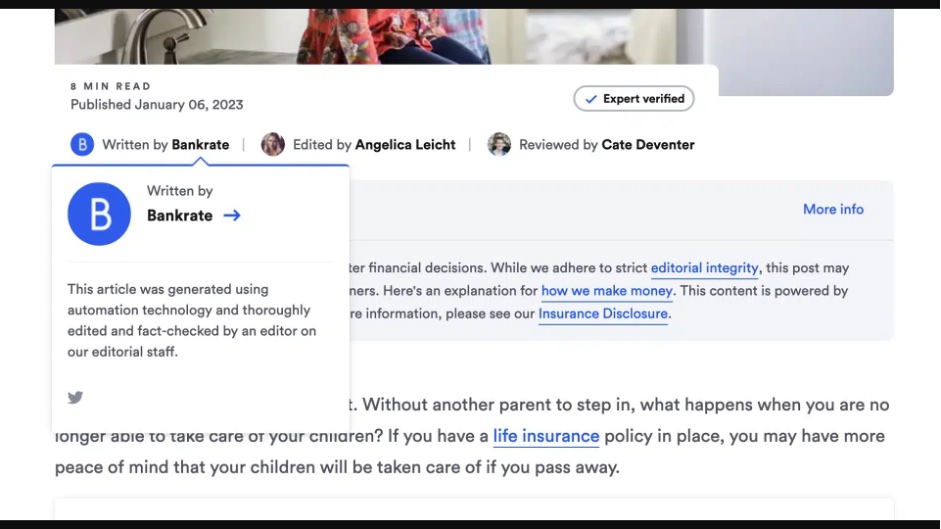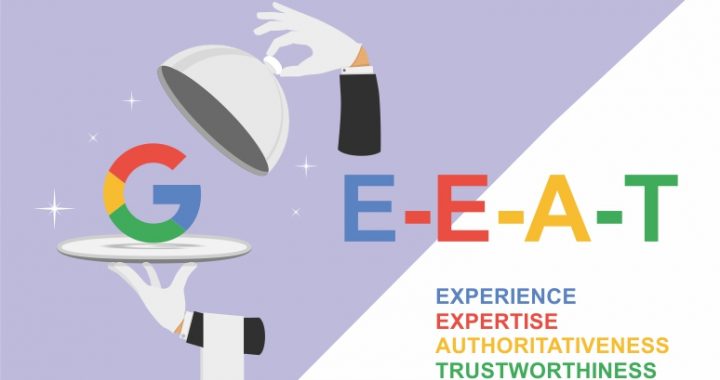When it comes to writing content, Google has always encouraged website owners to E-A-T. Google came up with that acronym to define the three things it looks for when determining whether a piece of content offers helpful and relevant information to its searchers:
- Expertise
- Authoritativeness
- Trustworthiness
The idea has always been to combine your expertise in your subject with authority, which often comes from first-hand knowledge, to create something your readers can trust. And that trust is a vital component in content, especially if you’re writing to advertise a brand or product. A Harvard Business Review piece from June 2022 shows that over 80% of consumers consider trust a leading factor when making a buying decision, so it stands to reason that Google wants to serve content it believes readers can trust.
Getting a good Google EAT rating has long been one of the best ways to ensure your content climbs Google’s rankings. But with the addition of a new “E” into the mix, it may be time for writers to reconsider how they write if they want to create Google EAT SEO-ready content.
The Basics of EAT
Before we get into the new “E” and what it might mean for your website, it’s worth exploring the basics of the EAT concept.
EAT (now EEAT or double-EAT) is a set of guidelines that Google delivers to third-party Google quality raters, who use the guidelines to figure out whether the content served is likely to meet a searcher’s needs.
To do that, they’ve traditionally judged the content based on the three factors we shared earlier:
Expertise
A search quality rater looks into the person behind the content to figure out if they have the expertise necessary to deliver the piece. What qualifications do they have? Do they have a track record in their industry?
Everyday expertise can also fall into this category. A great example is a gamer who reviews a video game despite not having experience in game development or a journalistic degree.
Authoritativeness
Working hand-in-hand with expertise, authoritativeness is about your reputation in your niche. Suppose we use the videogame reviewer example again. In that case, a review by somebody who isn’t a journalist can still be authoritative if a major gaming website, such as IGN, hosts that review. The site’s authority combines with the reviewer’s to create a good rating.
Contrast that to the first review written by somebody on a brand-new blog, which carries far less authority.
Trustworthiness
Expertise, authoritativeness, and now experience combine to help a search quality rater determine how trustworthy your content (and the related site) is. But the EEA part of EEAT is far from the only trust factor the raters look for, as they’re also looking to see that the rest of the site gives off the signals that tell a user they can trust it.
For example, suppose your site has a store that doesn’t have a Secure Socket Layer (SSL) certificate. That’s a strike against trustworthiness because you’re not doing enough to secure transactions. By a similar token, sites that collect data about their users lose trust if they don’t have visible privacy policies defining how they use that data. Having no physical address listed, no phone number, and no way to contact the site’s owners are all trust issues that could lead to a low EEAT score, even if you have the other three elements of EEAT in check.

The Role of Search Quality Raters in EEAT
We mentioned search quality raters before, so it’s worth delving into that topic before we get to the new “E” in EEAT.
Google employs third-party raters from all over the world to provide unbiased and independent opinions about the quality of the results produced by searches. The EEAT system is the set of guidelines that these raters receive, with the ideal results demonstrating the expertise, experience, and authoritativeness that lead to the quality rater feeling like they can trust the content.
So, unlike many of Google’s methods of determining content quality, the EEAT system is human-based. The feedback it generates helps Google focus on making sure its results offer people-first content designed to answer questions ahead of gaming its search engine algorithms.
Ultimately, these raters are trying to determine if your content (as well as the site it’s hosted on) is credible. The better your website’s EEAT, the more likely it will rank well. And if it’s not ranking well right now, despite having a solid EEAT, the idea is that Google will use the feedback they get from their search quality raters to adjust their algorithms so your high-level EEAT content gets ahead.
Introducing the New “E” – Experience
Have you ever read a product review that was little more than a recounting of the features you can find on any sales page for the product? You get the immediate sense that the writer doesn’t have first-hand experience using the product, which means you can’t trust what they say about it. After all, if you just wanted to read about the product’s features, you could go directly to the manufacturer. With a review, you want to find out if those features actually affect how the product works and what it does for the user.
These sorts of reviews demonstrate a lack of experience, be that with the product or the niche it slots into, and it’s these pieces that Google aims to confront with its latest update to its guidelines for search quality raters.
Hence, the introduction of a new “E” to EAT – Experience.
With the new EEEAT system, Google’s looking for content to demonstrate some degree of experience to go along with the expertise and authoritativeness it previously (and still) wanted to see. The EEAT Google quality rater asks questions about whether the content demonstrates actual first-hand use or experience with the subject of the writing.
Product reviews are the obvious example, though there are plenty more. If a website offers a restaurant review, Google’s looking for proof (such as pictures or first-hand knowledge of the restaurant’s menu) to see that the review isn’t cobbled together from other reviews found online. Beyond that, it seems likely that Google will use the new “E” to dig into the people behind the sites that post review-type content. Search Engine Land highlights this in an article about the updated EEAT guidelines, as it shares this quote from Google:
“Start by finding out who is responsible for the website and who created the content on the page… Then, look for information about the website and/or content creators on the website itself.”
That tells us that Google isn’t only looking for individual pieces to demonstrate first-hand experience on the writer’s part. It’s also looking at the website hosting the content to find evidence that the piece fits within the site’s niche, meaning the experience in the article meshes with the expertise you’d assume from the site.
What is EEAT SEO?
In some ways, the EEAT rating system is the embodiment of what Google wants to achieve with its search engine algorithms. By using third-party human quality raters, Google can see whether the content it serves meets its goal of only serving relevant, timely, and valuable information to its searchers.
So, when it comes to SEO for EEAT, you’re not really thinking about inserting keywords and making sure the on-site technical stuff is where it’s supposed to be. The algorithms deal with that stuff. Search quality raters’ only goal is to confirm that your website (and the content it hosts) is written with a people-first approach that showcases your expertise to prove the reader can trust you.
That may seem difficult, especially if you’re using article writing service providers to create the content you host on your site. Those providers may not have the first-hand experience needed for the new “E” of EEAT, plus they’re not necessarily experts in your industry. Still, there’s plenty you can do to ensure your site and its content get solid EEAT ratings, as these tips demonstrate.

Tip 1 – Share Your Knowledge with Your Article Writers
Let’s confront the elephant in the room immediately – many brands outsource their content to third-party blog writing services. According to Business Wire, 49% of brands either outsource all of their content creation or blend outsourced work with their in-house experience. If that’s the case, it doesn’t seem easy to get the experience and expertise parts of the EEAT formula right, as outsourcing means you’re not writing directly from your own knowledge.
There are a couple of ways to get around this issue.
First, focus on finding high-quality article writing services with an excellent track record that can demonstrate experience in writing within your industry. Ask for samples, quiz previous clients, and interview your potential content providers to check how much they know about what you do and how they can apply that knowledge to the content they create.
Tip 2 – Load Your Articles with Evidence of Experience
The written word alone doesn’t always do a good enough job of conveying your experience in a subject, especially in the case of reviews. Often, you will need some imagery to enhance the trust factor. And we’re not talking about standard product pictures that you can pull from a manufacturer’s website. You need photos (and even videos) that demonstrate you have first-hand experience using the product yourself.
Your readers want to see the real people behind the review, as evidenced by a statistic shared via The SEM Post. It says that consumers are seven times more likely to trust social content, such as pictures and videos, that feature real people over basic advertising that just tells them what a product does.
To translate that to your website’s content, you can boost the trust factor by sharing pictures of you using the product you’re reviewing directly. If you’re talking about the food at a restaurant, a snap of you and your friends at your table is a significant trust factor. These images prove that you’ve been there, done that, and are now telling the tale of what you experienced rather than regurgitating what somebody else said.
Tip 3 – Be Wary of AI-Generated Content
The rise of Jasper, ChatGPT, and similar AI-based content generation software seems like it should be a watershed moment for brands that want to pump out content quickly. What’s more, we’re seeing big brands getting behind AI-generated content, as Search Engine Land reports when looking at how Bankrate started to use AI to create articles it posts on its site:

We’re not going to say that businesses shouldn’t use AI at all when creating content. The technology is here, and it’s not going anywhere. However, there’s a section of this image that’s worth closer attention:
“This article was generated using automation technology and thoroughly edited and fact-checked by an editor on our editorial staff.”
The reason we’ve bolded the latter half of that statement is that it demonstrates that relying on AI alone to create content isn’t a good idea, especially if you want a higher Google EEAT rating. AI is prone to making factual and grammatical mistakes that eat away at the trustworthiness of your articles.
If you want to use AI to generate content, consider it more as a way to outline some points you can delve into in more detail rather than a way to quickly knock some articles together.
Tip 4 – Collaboration Creates Expertise (And Delivers Experience)
It’s impossible for any single person or business to know everything there is to know about their industry. But that lack of knowledge doesn’t have to stop you from covering specific topics as long as you demonstrate that you’ve either learned about the subject or have spotlighted somebody who knows what you don’t know.
That’s where collaboration comes in.
On the basic level, a collaboration could be as simple as interviewing an expert about the subject of their expertise. You’re not presenting yourself as the expert in this scenario. Instead, you (and, by extension, your website) are the conduit for sharing somebody else’s expertise. We’d even argue that deferring to somebody who knows more than you about a subject is a great trust factor because it shows that you’re not willing to speculate when you don’t know an answer.
However, collaboration can come in other forms. Take most of the links we’ve shared to other websites in this article as an example. Though we haven’t directly collaborated with those websites to create this piece, we’ve collaborated indirectly by highlighting them as the sources of facts, figures, or some form of expertise we didn’t have ourselves until we checked those sources. That indirect collaboration creates a virtual paper trail that readers (and search quality raters) can follow to determine that the content we share meets Google EEAT guidelines.
Tip 5 – Make Everything Easy for Visitors
Let’s say that somebody visits your website, reads a piece of content, and wants to get in touch with you to ask some questions. They scroll up to your site’s navigation bar and can’t find a contact page. So, they start searching the rest of the site for a form, a phone number, or any other way they can contact you.
They don’t find anything.
How much do you think that person will trust your website now that they believe you are deliberately obscuring your contact information?
Thankfully, the contact information problem is an easy one to solve, as making that information visible in a suitable place on your site means the problem disappears. But the point here is that you have to make it easy for visitors to verify anything you share on your site. Beyond contact information, you need to share links or citations to back up the claims you make in articles. Design your site so it’s easy to navigate, thus making it easier for people to spot the information they need.
The easier it is for somebody, such as a search quality rater, to get around your website, the better it is for your EEAT rating. Ease of use shows you have nothing to hide, which feeds into the trustworthiness factor and simplifies visitors’ access to examples of your expertise and experience.
Master Google EEAT
Far from seeing Google’s EEAT rating system and this most recent update to it as the enemy, we believe this change spells good things for content creators. By bringing first-hand experience into the mix and melding it with the expertise, authoritativeness, and trustworthiness that Google already wants to see, EEAT will likely improve the quality of search results across the board.
Your task (as well as ours) is to ensure that every piece of content you create satisfies the guidelines that a Google quality rater follows when examining content. Mastering EEAT isn’t about little tricks and techniques you can use to achieve a higher ranking. By simply creating great content, and hosting that content on a website that fires off trust signals left, right, and center, you ensure that your content gets a strong Google EEAT rating.
